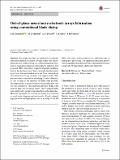Out-of-plane neural microelectrode arrays fabrication using conventional blade dicing
Author(s)
Oliveira, M. J.; Peixoto, A. C.; Correia, J. H.; Goncalves, S. B; Silva, A. F.
Download170_2015_Article_7948.pdf (16.97Mb)
PUBLISHER_POLICY
Publisher Policy
Article is made available in accordance with the publisher's policy and may be subject to US copyright law. Please refer to the publisher's site for terms of use.
Terms of use
Metadata
Show full item recordAbstract
\This paper describes an optimized out-of-plane fabrication method for neural 3D high-aspect-ratio microelectrode array (MEA) based on a dicing technology platform (a standard procedure in semiconductor industry). The proposed MEA fabrication required important modifications in the dicing process. Since electrodes length reaches up to 4 mm, the main hindrance was the 2 mm cutting depth limit allowed for dicing machines with regular blades. This new procedure consisted on modifying Z-axis calibration, so cuts as deep as the exposure of blades were possible. The employment of proper blades for each fabrication step was also mandatory. Thin and high-exposure blades were used for deep cuts in silicon wafers, and V-shaped blades were employed to produce sharpened tips on the electrodes. Moreover, parameters as very low-cut speeds were essential to avoid wafer chipping and microcracks. Results showed high-precision and high-quality cuts in all steps of the 3D MEA fabrication, without unnecessary additional steps of etching post-processing. The optimized fabrication process was successfully demonstrated with a 3D neural probe array comprising 36 individually addressable electrodes.
Date issued
2015-10Department
MIT-Portugal ProgramJournal
The International Journal of Advanced Manufacturing Technology
Publisher
Springer London
Citation
Goncalves, S. B. et al. “Out-of-Plane Neural Microelectrode Arrays Fabrication Using Conventional Blade Dicing.” The International Journal of Advanced Manufacturing Technology 85.1–4 (2016): 431–442.
Version: Author's final manuscript
ISSN
0268-3768
1433-3015